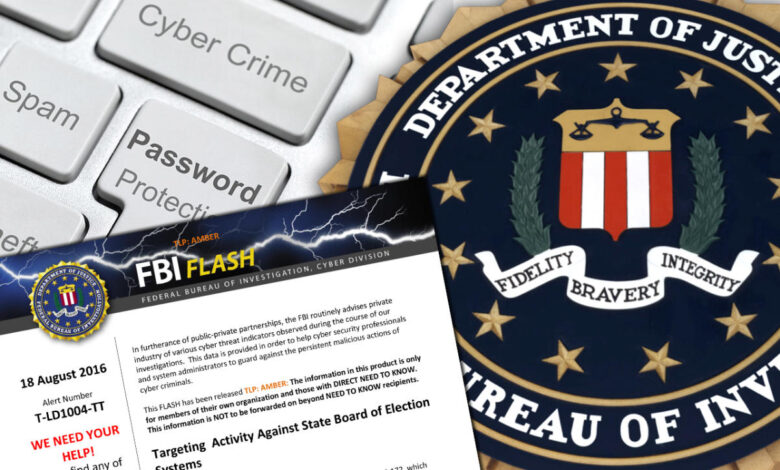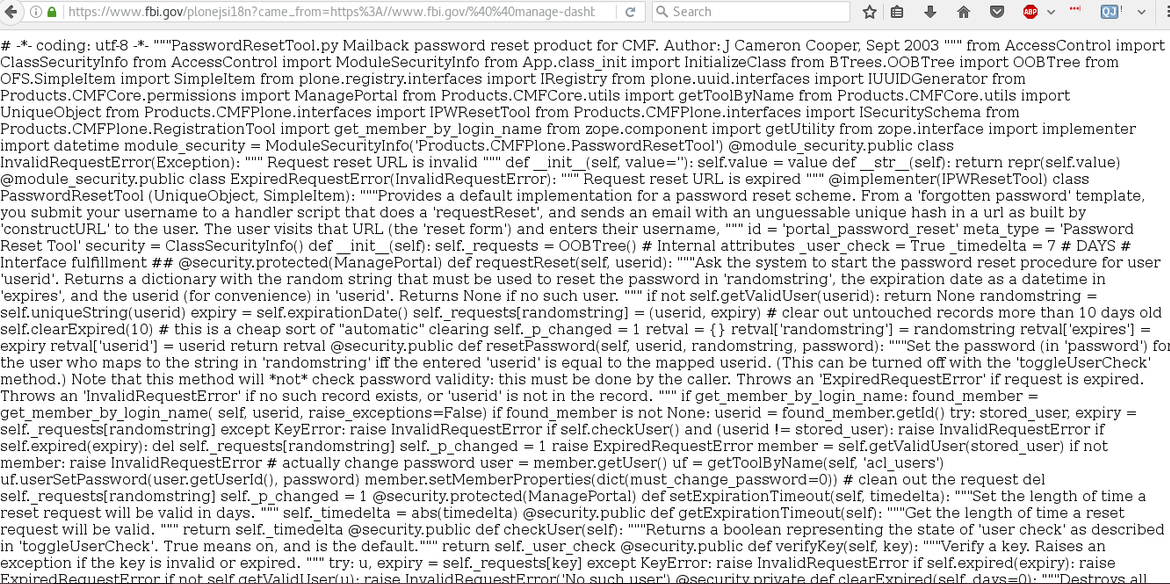
FBI Starts Fooling Hackers With Fake Data
FBI starts fooling hackers with fake data to find their whereabouts – it sounds like a spy movie plot, right? But this is real-life cybersecurity, and the FBI’s strategy is surprisingly clever. They’re creating elaborate digital traps using fake data to lure hackers, allowing them to track down cybercriminals and gather crucial evidence. This isn’t just about catching the bad guys; it’s also about understanding the evolving tactics of hackers and strengthening our overall online defenses.
The implications are huge, raising interesting questions about ethics, legality, and the ever-escalating arms race between cybersecurity experts and malicious actors.
The FBI’s approach involves crafting incredibly realistic fake data – everything from decoy files and websites to entire fake networks. Hackers, lured by the promise of valuable information or easy targets, unwittingly interact with this fabricated data, leaving behind a digital trail that leads directly back to them. The FBI then uses this trail, analyzing IP addresses, digital fingerprints, and other digital traces, to identify and apprehend the culprits.
But this isn’t a simple game of cat and mouse; it’s a complex operation with significant legal and ethical considerations. The balance between effective law enforcement and the potential for misuse of this technology is a critical discussion point.
The FBI’s Strategy
The FBI’s deployment of deceptive tactics in cyberspace represents a significant shift in their approach to combating cybercrime. Instead of solely relying on reactive measures, they’re proactively engaging with malicious actors, using carefully crafted “honey traps” of fake data to lure them in and ultimately expose their locations and operations. This strategy, while undeniably effective, raises crucial questions about its legal and ethical implications.The FBI’s approach involves creating highly realistic datasets designed to mimic genuine information a hacker might find valuable.
This could include anything from seemingly legitimate financial records to sensitive government documents or proprietary company information. By planting this bait online, the FBI can attract hackers who, upon accessing and interacting with the fake data, inadvertently reveal their IP addresses, network infrastructure, and even operational techniques. The data itself is carefully monitored, providing investigators with a detailed trail of the hacker’s activities, allowing them to build a strong case for prosecution.
Legal and Ethical Considerations of Deception in Cyber Warfare
The use of deception in cybersecurity operations treads a fine line legally and ethically. The FBI must ensure that their tactics comply with existing laws and regulations, including those related to wiretapping, computer fraud, and unauthorized access. Furthermore, the ethical implications are substantial. While the goal is to apprehend cybercriminals, the potential for unintended consequences exists. For example, the line between entrapment and legitimate investigative techniques can be blurred.
Careful consideration must be given to ensuring that the FBI’s actions do not violate the rights of individuals, even those suspected of criminal activity. Transparency regarding the use of such tactics is also crucial for maintaining public trust. The legal framework surrounding these operations needs constant review and adaptation to keep pace with the evolving cyber landscape.
Technical Challenges in Creating Convincing Fake Data
Creating convincing fake data presents significant technical challenges. The data must be realistic enough to attract sophisticated hackers but also subtly flawed to allow investigators to identify those who access it. This requires a deep understanding of the target’s likely motivations and technical capabilities. The fake data needs to seamlessly integrate into existing systems and avoid triggering any security alerts.
The FBI likely employs teams of highly skilled cybersecurity experts and data scientists to develop and maintain these deceptive environments. The process also requires rigorous testing to ensure that the data is believable and that the monitoring mechanisms are robust and reliable. A single flaw could compromise the entire operation, potentially alerting the hackers and allowing them to escape detection.
Comparison with Other Cybersecurity Measures
The FBI’s deceptive strategy complements more traditional cybersecurity measures such as intrusion detection systems and incident response teams. While these approaches primarily focus on detecting and responding to attacks after they occur, the deceptive tactic proactively lures attackers, allowing for earlier detection and potentially preventing larger-scale damage. It can also provide valuable intelligence on the techniques and capabilities of advanced persistent threats (APTs), informing the development of more effective defensive strategies.
However, it is not a replacement for other security measures. A multi-layered approach combining proactive deception with robust defensive mechanisms provides the strongest overall security posture. The success of this strategy depends heavily on the quality of the fake data and the ability to monitor and analyze the interactions with it.
Types of Fake Data Employed
The FBI’s deployment of fake data to trap cybercriminals is a sophisticated cat-and-mouse game. Understanding the types of deceptive information used is crucial to appreciating the effectiveness and inherent risks of this strategy. The FBI likely employs a multi-layered approach, combining various forms of fake data to create a convincing and alluring trap for unsuspecting hackers.The characteristics of effective fake data are multifaceted.
It must appear authentic to the target, enticing enough to warrant investigation, and designed to lead the hacker towards a controlled environment where their activities can be monitored and their identities revealed. The data should also be tailored to the specific type of hacker and their known interests or targets, making the lure more persuasive and less likely to be dismissed as a trap.
Decoy Files and Folders
Decoy files and folders are designed to mimic legitimate data that would be attractive to a specific type of hacker. For example, a file labeled “Confidential_Financial_Data.xlsx” placed in a seemingly accessible location on a compromised network could entice a hacker looking for sensitive financial information. The file itself would contain harmless data, or perhaps data designed to mislead the hacker about the true nature of the network.
The act of accessing and downloading this file would provide the FBI with valuable information about the hacker’s activities and potential location. These decoys can be further enhanced by embedding them within a larger, more complex network of fake files and folders to make the trap more convincing.
Fake Websites and Web Servers
Creating convincing fake websites is another key tactic. These websites might mimic legitimate government, financial, or corporate sites, designed to lure hackers interested in data breaches or phishing scams. The FBI could monitor activity on these sites, gathering information about the hacker’s techniques, IP addresses, and other identifying information. These fake websites could even contain intentionally vulnerable systems, designed to lure hackers into attempting attacks, thereby revealing their methods and skills.
The effectiveness of this tactic relies on the realism of the website’s design and functionality.
The FBI’s clever tactic of deploying fake data to trap hackers is fascinating; it’s a cat-and-mouse game on a massive scale. This kind of sophisticated data manipulation reminds me of the complex systems discussed in this article on domino app dev the low code and pro code future , where building robust and secure applications is key. Ultimately, whether it’s building a secure app or catching cybercriminals, understanding the underlying data structures is crucial for success.
Bogus Networks and Honeypots
The FBI might also set up entire bogus networks or honeypots – seemingly vulnerable networks designed to attract and trap hackers. These networks could contain a range of decoy files, servers, and systems, each designed to lure hackers with different interests. Honeypots allow the FBI to observe hacker behavior in a controlled environment, collecting extensive data on their techniques and activities without risking real-world systems.
The information gathered from honeypots can be invaluable in identifying and apprehending cybercriminals.
Comparison of Fake Data Types
| Data Type | Effectiveness | Risk | Example Use Case |
|---|---|---|---|
| Decoy Files | High (if well-crafted and targeted) | Moderate (risk of revealing sensitive information if compromised) | Luring a hacker interested in financial data with a fake spreadsheet containing seemingly valuable information. |
| Fake Websites | High (if convincingly designed and hosted) | High (risk of attracting unwanted attention and compromising real systems if poorly secured) | Mimicking a bank’s login page to capture login credentials from phishing attempts. |
| Bogus Networks/Honeypots | Very High (allows for in-depth observation of hacker behavior) | High (requires significant resources and expertise to maintain and secure) | Creating a simulated network environment to attract advanced persistent threats (APTs) and observe their tactics. |
Tracking and Identifying Hackers: Fbi Starts Fooling Hackers With Fake Data To Find Their Whereabouts
The FBI’s deployment of fake data isn’t just a trap; it’s a sophisticated tracking system. By carefully crafting enticing but ultimately deceptive information, agents lay a digital trail leading back to the perpetrators. The interaction with this fake data provides a wealth of information, allowing investigators to pinpoint the source of the cyberattack.The process of tracking and identifying hackers who interact with this fake data relies heavily on collecting and analyzing various digital traces left behind.
This isn’t about simply catching a glimpse; it’s about building a robust case based on irrefutable evidence.
IP Address Tracking and Analysis
The most immediate piece of information gathered is the hacker’s IP address. Every device connected to the internet has a unique IP address, acting like a digital postal code. When a hacker accesses the fake data, their IP address is logged. However, this isn’t always straightforward. Many hackers use techniques like VPNs (Virtual Private Networks) and proxies to mask their true IP address.
The FBI employs advanced techniques to pierce through these layers of obfuscation, analyzing network traffic patterns and correlating data from multiple sources to identify the real IP address behind the mask. Successful identification often involves cross-referencing the IP address with other data points to confirm its legitimacy and location. For example, an IP address traced to a known botnet server would be treated differently than one linked to a residential address.
Digital Fingerprint Analysis
Beyond the IP address, the FBI collects a “digital fingerprint” of the hacker’s system. This fingerprint includes details like the operating system, browser type and version, installed plugins, and even specific settings. This information is gathered through the analysis of HTTP headers and other metadata transmitted during the interaction with the fake data. The combination of these characteristics creates a unique identifier, much like a physical fingerprint, allowing investigators to distinguish between different hackers and track their activities across multiple sessions and even different attacks.
Variations in these fingerprints over time can also provide insights into the hacker’s methods and evolution of their techniques.
Flowchart: Identifying a Hacker from Fake Data Interaction
The following describes a simplified flowchart illustrating the process:[Imagine a flowchart here. The flowchart would begin with “Hacker interacts with fake data,” branching to “IP address logged,” “Digital fingerprint collected,” and “Other digital traces (e.g., timestamps, file access patterns) gathered.” These branches would converge at “Data Analysis,” leading to “Suspect Identification” and then “Evidence Gathering and Case Building.”]
Evidence Gathering and Case Building
Once a suspect is identified, the FBI meticulously gathers evidence to build a strong case. This involves correlating the digital traces with other information, such as financial records (if the attack involved financial gain), communication logs, and potentially physical surveillance (in cases requiring further investigation). The collected evidence is then carefully analyzed and presented in a manner that satisfies legal requirements for prosecution.
Building a successful case requires a meticulous approach, ensuring every piece of evidence is properly documented and its chain of custody is maintained. This process can involve multiple specialized teams, from cyber forensic analysts to legal experts, all working together to achieve a successful prosecution.
The Hacker’s Perspective
The FBI’s deployment of fake data to track down cybercriminals presents a fascinating challenge for hackers. It’s a game of cat and mouse, where the stakes are high and the consequences of miscalculation can be severe. Understanding how the FBI might employ these tactics and developing effective countermeasures is crucial for maintaining operational security. This involves not only detecting the deception but also potentially turning the FBI’s own strategies against them.Detecting and Avoiding FBI Deception Tactics involves a multi-layered approach.
Hackers need to be vigilant and employ a range of techniques to identify potential traps. Simple strategies like verifying data integrity against multiple sources and analyzing traffic patterns for anomalies are fundamental. More advanced methods involve examining the metadata associated with the data, looking for inconsistencies or unusual patterns that might indicate manipulation.
Data Integrity Verification and Anomaly Detection
Sophisticated hackers will utilize checksums and cryptographic hashing to verify the integrity of any data received. Discrepancies between expected and received hashes immediately flag potential manipulation. Furthermore, they’ll meticulously analyze network traffic patterns, looking for unusual bursts of activity, unexpected connections, or oddly formatted packets – all potential signs of a honeypot or a similar trap. For example, an unusually large file download from an unexpected source might be cause for suspicion.
The FBI’s clever tactic of using fake data to trap hackers is a fascinating cat-and-mouse game, highlighting the constant need for robust security measures. This brings to mind the importance of proactive cloud security, especially with the rise of solutions like bitglass and the rise of cloud security posture management , which are crucial in preventing breaches before they happen.
Ultimately, both the FBI’s strategy and the advancements in cloud security are vital in the ongoing battle against cyber threats.
Similarly, repeated requests for the same piece of information from different IP addresses could suggest a sting operation.
Metadata Analysis and Behavioral Biometrics
Beyond the data itself, hackers will examine the metadata. This includes timestamps, file origins, and other embedded information. Inconsistent or illogical metadata can be a strong indicator of tampering. Moreover, advanced hackers might even utilize behavioral biometrics. This involves analyzing the behavior of the system, including response times and network latency, to identify anomalies.
For example, an unusually slow response time to a seemingly simple request could suggest the system is under heavy load due to monitoring or data analysis by law enforcement.
Exploiting and Manipulating Fake Data
A highly skilled hacker might attempt to exploit the fake data itself. They could potentially modify or corrupt the data in a way that misleads the FBI investigation, leading them down a false trail. Alternatively, they could use the fake data as a cover to conduct further malicious activities, hiding their true intentions behind a smokescreen of seemingly legitimate activity.
Imagine a scenario where a hacker intercepts and modifies fake data intended to lure them into a trap; they could then retransmit the modified data, creating a false positive and potentially compromising the FBI’s investigation.
Countermeasures for Hackers
The following countermeasures can help hackers protect themselves from FBI operations using fake data:
- Employ robust data validation techniques, including checksum verification and cryptographic hashing.
- Utilize network traffic analysis tools to identify anomalies and suspicious patterns.
- Analyze metadata thoroughly for inconsistencies or unusual characteristics.
- Implement strong encryption and security protocols to protect communications and data.
- Utilize anonymization and obfuscation techniques to mask their true identity and location.
- Employ virtual private networks (VPNs) and other privacy-enhancing technologies.
- Regularly update security software and patches to mitigate vulnerabilities.
- Maintain operational security (OPSEC) best practices, including secure communication channels and compartmentalization of information.
Ethical and Legal Implications
The FBI’s deployment of deceptive techniques in cybersecurity operations, while potentially effective in apprehending cybercriminals, raises significant ethical and legal concerns. The balance between national security and individual rights becomes acutely precarious when employing tactics that intentionally mislead and manipulate. This section explores the complexities of this strategy, examining its ethical underpinnings and the legal framework that governs its application.The primary ethical concern revolves around the potential for deception to erode public trust.
The FBI’s actions, if perceived as overly aggressive or lacking transparency, could damage the public’s confidence in law enforcement’s commitment to upholding ethical standards. Furthermore, the use of deceptive techniques raises questions about the potential for manipulation and coercion, especially when targeting vulnerable individuals or groups. There’s a fine line between necessary deception to catch criminals and unethical manipulation that violates fundamental principles of fairness and due process.
Ethical Considerations in Deception
The use of deception in cybersecurity operations necessitates a careful ethical assessment. A key principle is proportionality – the level of deception employed should be proportionate to the severity of the crime and the potential harm to the public. Moreover, transparency, where feasible, is crucial. While complete transparency might compromise the investigation, informing the public about the general nature of such techniques, when possible, can help maintain trust and accountability.
The potential for unintended consequences, such as the erosion of trust in online interactions or the chilling effect on legitimate online activities, must also be carefully considered. A robust ethical framework, incorporating principles of proportionality, transparency, and accountability, is essential to guide the application of deceptive techniques.
Legal Framework Governing Digital Evidence, Fbi starts fooling hackers with fake data to find their whereabouts
The legal framework governing the collection and use of digital evidence obtained through deceptive techniques is complex and evolving. The Fourth Amendment of the US Constitution protects against unreasonable searches and seizures, and the admissibility of evidence obtained through deception is subject to judicial scrutiny. Courts typically evaluate the legality of such methods based on the reasonableness of the deception in relation to the circumstances of the investigation.
For example, the use of honeypots – decoy systems designed to attract and trap hackers – is generally considered acceptable, provided they are not designed to induce criminal behavior. However, more sophisticated forms of deception, such as the creation of elaborate fake personas or the deployment of malware disguised as legitimate software, require careful consideration of legal implications.
The Electronic Communications Privacy Act (ECPA) and other relevant legislation further shape the legal landscape governing the collection and use of digital evidence. Compliance with these laws is paramount to ensure the integrity and admissibility of evidence gathered through deceptive means.
Potential for Misuse and Abuse
The potential for misuse and abuse of deceptive techniques in cybersecurity investigations is a significant concern. The power to manipulate and mislead carries inherent risks, and safeguards are needed to prevent its abuse. There’s a risk that these techniques could be used against innocent individuals, leading to wrongful accusations or convictions. The lack of transparency and the potential for covert surveillance create opportunities for overreach and abuse of power.
Furthermore, the development and deployment of sophisticated deceptive techniques require a high degree of technical expertise, raising concerns about the potential for these capabilities to fall into the wrong hands. Robust oversight mechanisms, including independent audits and regular reviews of policies and procedures, are crucial to mitigate the risks of misuse and abuse.
Comparison with Other Law Enforcement Agencies
While the FBI’s approach to using fake data to track hackers is not unique, the specifics of its implementation and the scale of its operations might differ from those of other law enforcement agencies. International cooperation and information sharing are crucial in combating transnational cybercrime, and different countries have varying legal and ethical frameworks governing cybersecurity operations. Some agencies might rely more heavily on collaborative efforts with private sector companies, while others might prioritize covert operations.
The extent to which deceptive techniques are employed also varies depending on the legal and regulatory environments, as well as cultural norms and public perceptions of law enforcement. A comparative analysis of the strategies employed by various law enforcement agencies can offer valuable insights into best practices and potential pitfalls. Understanding these differences is critical for developing effective and ethical cybersecurity strategies on a global scale.
Future Developments and Predictions

The FBI’s use of fake data in cybercrime investigations is a rapidly evolving field, driven by advancements in technology and the ever-shifting landscape of cyber threats. Predicting the future with certainty is impossible, but analyzing current trends allows us to foresee likely developments and potential responses from both law enforcement and the criminal element. This includes examining the growing role of AI and machine learning, and anticipating how hackers will adapt their strategies to counter these new tactics.The integration of artificial intelligence and machine learning will significantly shape the future of this cat-and-mouse game.
AI can automate the creation of incredibly realistic fake data sets, tailoring them to specific targets and scenarios with unprecedented efficiency. This will allow for larger-scale operations and the ability to create more convincing decoys, effectively luring hackers into traps. Simultaneously, AI-powered systems will analyze vast amounts of data to identify patterns and anomalies, improving the accuracy and speed of identifying malicious actors within the complex digital landscape.
This improved detection capability will allow law enforcement to proactively identify and disrupt attacks before they cause significant damage.
Artificial Intelligence and Machine Learning in Data Creation and Detection
AI and machine learning will play a dual role – enhancing both the creation and detection of fake data. For creation, AI algorithms can generate synthetic data that mimics real-world data with remarkable fidelity. This could involve creating realistic-looking databases, network traffic patterns, or even simulated online personas. For detection, AI can analyze network activity and identify suspicious patterns that might indicate interaction with fake data or unusual behavior indicative of a hacker’s presence.
For example, an AI system could detect anomalies in data access patterns, identifying unusual login attempts or data downloads that could point to a hacker interacting with a trap set by the FBI. This would allow for more efficient resource allocation, focusing investigations on genuinely suspicious activities rather than wasting time on benign occurrences.
The FBI’s clever strategy of using fake data to trap hackers is fascinating, highlighting the cat-and-mouse game of cybersecurity. It makes me wonder about the scale of data breaches, especially considering news like this article detailing Facebook’s request for bank account info and card transactions of users: facebook asking bank account info and card transactions of users.
This raises serious privacy concerns, mirroring the need for proactive measures like the FBI’s approach to combatting cybercrime.
Hacker Adaptations and Future Scenarios
Hackers will undoubtedly adapt to the increased sophistication of the FBI’s tactics. We can expect to see an increase in the use of advanced detection techniques by hackers to identify and avoid traps. This could include employing their own AI-powered tools to analyze network traffic and identify patterns indicative of fake data or deception. They may also move towards more decentralized and anonymous methods of operation to avoid detection.
The development of more sophisticated encryption and obfuscation techniques will also likely become more prevalent.
A Hypothetical Future Scenario
Imagine a future where the FBI deploys a vast, AI-managed network of honeypots, each populated with highly realistic fake data designed to lure specific types of hackers. These honeypots would dynamically adapt their data and behavior based on the actions of the hackers, leading them deeper into the trap. Simultaneously, AI-powered systems would analyze the hackers’ actions in real-time, identifying their techniques, identifying their location, and potentially even their real-world identities.
In response, hackers utilize their own AI-driven tools to identify and bypass the honeypots, employing advanced encryption and decentralized communication protocols to mask their activities. This would represent a significant escalation in the ongoing cyber arms race, with both sides leveraging the power of AI to gain an advantage. This dynamic scenario would highlight the constant need for both law enforcement and hackers to adapt and innovate in order to maintain their respective positions.
Closing Summary

The FBI’s use of fake data to track hackers is a fascinating and complex development in the ongoing fight against cybercrime. It highlights the lengths to which law enforcement agencies are going to stay ahead of increasingly sophisticated cyber threats. While the strategy raises important ethical and legal questions, its potential to disrupt cybercriminal activity is undeniable. The future will likely see an escalation of this digital arms race, with both sides employing increasingly advanced technologies and techniques.
The ongoing battle for cybersecurity dominance promises to be a captivating spectacle of technological innovation and strategic deception.
Questions and Answers
How does the FBI ensure the fake data is convincing enough to lure hackers?
The FBI likely employs experts in various fields, including software development, network engineering, and even social engineering, to create realistic and appealing fake data that mimics real-world targets.
What happens to hackers once they are identified through this method?
The FBI will likely investigate further, gather more evidence, and potentially pursue legal action, which could range from fines to imprisonment, depending on the severity of the crimes committed.
Can this method be used to target activists or whistleblowers?
This is a critical ethical concern. The potential for misuse exists, and strong legal safeguards and oversight are crucial to prevent the targeting of individuals exercising their rights to free speech or dissent.
What are the long-term implications of this strategy on the cybersecurity landscape?
This strategy will likely lead to an arms race, with hackers developing more sophisticated methods to detect and avoid such traps, and the FBI responding with even more advanced techniques.





